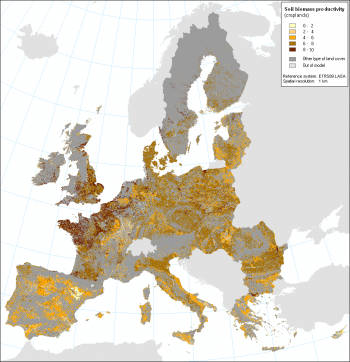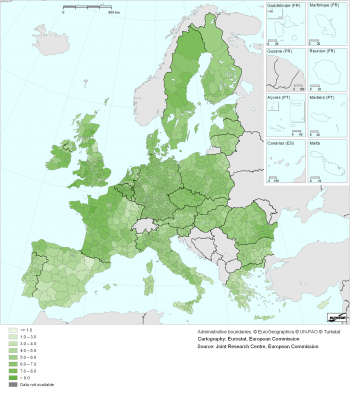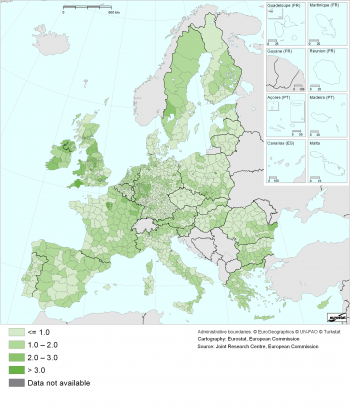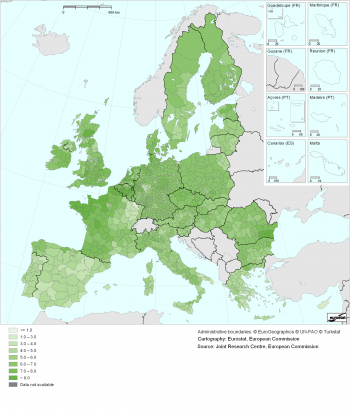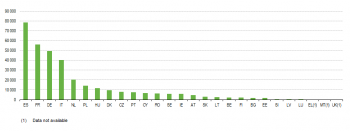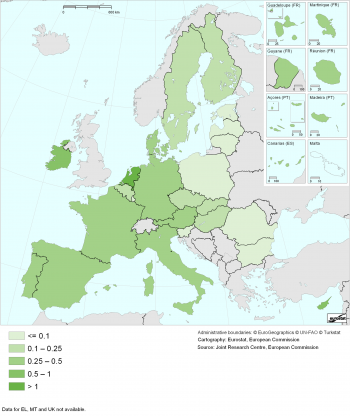Archive:Agri-environmental indicator - soil quality
This article has been archived. For further information about agri-environment, please see the Agri-environmental_indicators.
This article provides a fact sheet of the European Union (EU) agri-environmental indicator soil quality. It consists of an overview of recent data, complemented by all information on definitions, measurement methods and context needed to interpret them correctly. The soil quality article is part of a set of similar fact sheets providing a complete picture of the state of the agri-environmental indicators in the EU.
The indicator provides an account of the ability of soil to provide agri-environmental services through its capacities to perform its functions and respond to external influences.
In the agri-environmental context, soil quality describes:
- the capacity of soil to biomass production;
- the input-need to attain optimal productivity;
- the soil-response to climatic variability;
- carbon storage, filtering, buffering capacity.
Main indicator
- Agri-environmental soil quality index
Supporting indicators
- Sub-indicator 1: Productivity index
- Sub-indicator 2: Fertiliser response rate
- Sub-indicator 3: Production stability index
- Sub-indicator 4: Soil environmental services index
Main statistical findings
Key messages
Soil quality cannot be measured directly, therefore a model is provided to indicate its status across the EU. The model of agri-environemntal soil quality is developed to support planning and monitoring of resources use efficiency and sustainability of agricultural land use. Data from its sub domains (productivity index, fertiliser response rate) can be directly used to monitor developments based on the Resource efficiency roadmap of the EU, (COM(2011) 571 final), while the production stability index can be utilized in the formulation of adaptation and mitigation measures with regards to climate change. Soil environmental services are partly linked to climate change policy, and partly to environmental policies, such as the Nitrates Directive (Council Directive 91/676/EEC).
Assessment
The composite indicator, the agri-environmental soil quality index consists of four sub-indicators of similar weight which have relevance either to the agricultural and/or to environmental performance of soil.
- Productivity index - has relevance to agricultural policy field and measures the capacity of soil to biomass production.
- Fertiliser response rate - has relevance to agri-environmental policy field and measures the input-need to attain optimal productivity.
- Production stability index - has relevance to agricultural policy field and measures the soil-response to climatic variability.
- Soil environmental services index - has relevance to agri-environmental policy field and measures the carbon storage, filtering, transforming, and soil biodiversity.
For example in soil fertility evaluation the availability of water sets the target of fertility level. However, productivity can be altered by fertilisation. The degree of yield change to fertilisation is a distinct response property of each soil.
Supporting indicator 1 - Soil productivity index
The level on which the soil is delivering its biomass production service is evaluated on the basis of soil properties at prevailing climatic and topographical conditions. Since productivity is a result of the interaction of soil, climatic and topographical conditions, these factors need to be assessed in their complexity. Productivity differences of similar soils under intensive rainfed agricultural use and under grassland land cover vary with the changing availability of precipitation and differences in temperature regimes. For instance under temperate sub-oceanic climate, the rather stable thermal regime and balanced water availability of medium to high amount of precipitation not only secures plant available water on most soil types throughout the growing period, but facilitates decomposition and weathering throughout the year. These processes are limited under temperate continental or semi-arid Mediterranean climates, due to cold and/or arid periods in most years. With the increasing aridity at prevailing climates, the importance of soil physical and chemical properties in water and nutrient supply to plants is gaining increasing significance. Based on this principle of soil productivity processes, ranking of inherent productivity of soil has been performed by 8 major climatic areas.
Productivity index for croplands and grasslands are provided in Maps 1 - 4. Map 1 shows the soil biomass productivity of croplands in the European Union expressed in relative terms with indices without measurement units. Map 2 shows the soil biomass productivity of grasslands in the European Union expressed in relative terms with indices without measurement units. Map 3 shows the average productivity of croplands in each NUTS 3 region of the European Union. Please note, that this map does not consider the extent of croplands in the regions. Map 4 shows the variability of the cropland productivity in each NUTS 3 region, expressed through the standard deviation (SD). The higher the standard deviation, the more diverse the soil resource in the region is, from the viewpoint of its productivity (which in NUTS 3 regions also depend on topography).
Supporting indicator 2 - Fertiliser response rate
Since productivity of soil is only partly due to its inherent fertility, but also to the effect of management, mainly to nutrient input, the effect of fertilisation was considered in this module. While acknowledging the importance of the applied technology of soil use on the actual productivity of soil on a detailed scale, such distinctions were regarded as non-necessary to be directly incorporated in our continental scale study. The goal of our study was solely to determine soil productivity – i.e. the capacity of soil to supply nutrients, water and rooting medium for plants – in a comparative manner and not to assess the effects of management differences. It is recognized, that in the case of the realization of biomass productive capacity technological advancement plays a role if we compare regions of contemporary Europe on a continental scale. However, the efficiency of input use, consequently the selection of the most appropriate techniques and amount of input is also determined by biophysical conditions to a great extent; e.g. large regional crop yield differences within France are due to biophysical differences rather than differences in available technology, capital or other socio-economic conditions. Therefore to evaluate the effect of management we only considered the influence of fertilisation. To do this, we assigned a fertiliser response score to each soil unit in the seven climatic zones. Soils with the largest estimated relative fertility increase received the maximum of 8 points and soils with little influence of fertilisation received 1 point. For example an Albic Arenosol in the sub-oceanic climate has among the highest relative productivity increase due to proper fertilisation, while fertilisation has little effect on the crop productivity of Calcaric Rendzinas in the semi-arid Mediterranean.
To calculate soil productivity for the cropland land use type, the inherent soil productivity and the fertiliser response scores were aggregated. Spatially weighted average of productivity scores were calculated for the soil mapping units (SMUs) of the Geographical Soil Database of Europe (SGDBE). In order to avoid the bias originating from the evaluation of non-cropland soils, only those soil typological units (STUs) were considered, which have cultivated land as primary or secondary land use type in the SGDBE. Map 5 shows the fertiliser response rate of croplands in the European Union. Fertiliser response rate corresponds to the potential yield increase from extensive cropland management to intensive rainfed cultivation. On Map 6, the numbers are provided as means of NUTS 3 regions.
Supporting indicator 3 - Production stability
In the agri-environmental soil quality domain soil response properties are characterized by water and nutrient dynamics. Annual variations of yield depend on complex weather conditions, including precipitation and temperature regimes. The soil water element of productivity acts in interaction with the dynamics of nutrient availability. The water regime of soil types is reflected in the variability of yields over the years. This variety may differ to a great extent among soil classes. In the case of crop production the stability of yields is desirable. Therefore soil characteristics responsible for higher variability should be considered as indicators of negative response property and consequently lower index of the production stability sub-indicator. The development of this sub indicator is in progress.
Supporting indicator 4 - Soil environmental services
The evaluation of productivity-independent environmental services of the soil is an important need. From the agricultural production perspective one should always consider, whether soil functions other than biomass production can be related to the production potential or they have to be analyzed separately. Nevertheless, all analyses should be based on the same integrated dataset because this can secure the most accurate information in the most economical way.
There are a number of soil functions – as defined by the Soil Thematic Strategy – that contribute to the environmental quality of soil. Four of these functions are recommended to be evaluated in relation to agri-environmental measures:
- Organic carbon storage
This indicator expresses the organic carbon content of soils relative to the theoretical maximum amount they can hold.
- Substances filtering
Substances filtering capacity of any porous media is a function of the textural and colloid properties. There are a number of models available to quantitatively estimate filtering capacity of European soils (e.g. EuroPEARL for pesticides, 2002). These models can be applied for the assessment. The development of this sub indicator is in progress.
- Substances transforming
Several patterns of material transformation exist in soil. Aerobic and anaerobic biological decomposition plays a major role in these processes. Results of redox processes, such as stabilization of humus etc. may also bear great importance for specific functions. Material exchange between soil components as well as between soil and non-soil components is another major process of which the magnitude is determined by the substances transforming capacity of soil. Soils need to be assessed by the availability and strength of these processes. The development of this sub indicator is in progress.
- Biodiversity and biological activity
In order to answer agri-environmental policy questions the role of soil biodiversity needs to be addressed – among others - in terms of threshold values of influences from impacts and interpretation of the functioning of soil biodiversity[1]. The development of this sub indicator is in progress.
Data sources and availability
Indicator definition
The indicator provides an account of the ability of soil to provide agri-environmental services through its capacities to perform its functions and respond to external influences.
In the agri-environmental context, soil quality describes:
- the capacity of soil to biomass production;
- the input-need to attain optimal productivity;
- the soil-response to climatic variability;
- carbon storage, filtering, buffering capacity.
Measurements
Main indicator
Agri-environmental soil quality index
Supporting indicators
- Sub-indicator 1: Productivity index
- Sub-indicator 2: Fertiliser response rate
- Sub-indicator 3: Production stability index
- Sub-indicator 4: Soil environmental services index
Links with other indicators
The indicator "Agri-environmental commitments" is linked to the following other indicators:
- AEI 01 - Agri-environmental commitments
- AEI 04 - Area under organic farming
- AEI 05 - Mineral fertiliser consumption
- AEI 09 - Land use change
- AEI 10.1 - Cropping patterns
- AEI 10.2 - Livestock patterns
- AEI 11.1 - Soil cover
- AEI 11.2 - Tillage practices
- AEI 11.3 - Manure storage
- AEI 12 - Intensification/Extensification
- AEI 15 - Gross nitrogen balance
- AEI 16 - Risk of pollution by phosphorus
- AEI 17 - Pesticide risk
- AEI 19 - Greenhouse gas emissions
- AEI 20 - Water abstraction
- AEI 27.1 - Water quality - Nitrate pollution
- AEI 27.2 - Water quality - Pesticide pollution
- AEI 28 - Landscape - state and diversity
Data used and methodology
Input data
- Soil: European Soil Database
The European Soil Database v.2.0[2][3] has been constructed from source material prepared and published at a scale of 1:1 000 000 (CEC, 1985). The resulting soil data are harmonised for the whole area covered according to a standard international classification, together with analytical data for standard profiles. The spatial component of this database comprises polygons, which represent Soil Mapping Units (SMUs). These spatial elements are linked to one or more Soil Typological Units (STUs). Attribute data exist for STUs and so these data can be related to SMUs. Although each STU is unambiguously defined through a single set of parameters, SMUs may contain up to eight STUs. The spatial location of STUs within an SMU is not known, only the proportion of each STU in the SMU. In addition, many of the attributes are not stored as measured values but as codes relating to classes. While the structure of the European Soil Database allows for relatively efficient data storage, it is not particularly well suited for spatial analysis in raster format or combining external information, and for applying mathematical functions rather than rule-based systems. Therefore, a specific set of raster layers was produced based on an area-weighted distribution of attributes within SMUs. In the process, class values were transferred to continuous numeric values. Spatial representation of attributes was improved by performing a multi-criteria analysis within each SMU based on STU characteristics. The procedure provided a set of thematic layers, in which each soil parameter is stored in a single layer using continuous values for representation.
- Land use/cover: CORINE LC and USGS Eurasia
The land cover data were taken from a data set covering Europe with information according to the CORINE Land Cover (LC) classification codes. Since CORINE LC covers only part of the area of interest, land cover was supplemented with specifically adapted Eurasia land cover data, derived from a US Geological Survey (USGS) database, in areas, where CORINE data are absent. To achieve comparable thematic coverage between the CORINE and USGS data, a series of cross-classifications was carried out, using various USGS data layers and re-assigning or merging classes where appropriate. The final layer corresponds to CORINE level 3 classification codes. Global Land Cover Characterization dataset is also used during the validation process.
- Land use data of the Soil Geographical Database of Eurasia (SGDBE):
During the biomass productivity evaluation exercise we also used the land use data of the SGDBE (EC 2003). The SGDBE holds information on dominant and secondary land use types of each component STU of the soil map polygons. This information was useful to determine the soil type under agricultural use within the soil mapping unit (SMU).
- Climate data:
Europe has diverse climatic conditions, represented by climatic zones and areas. Rainfall characteristics and temperature regime seem to provide sufficient information for continental scale agro-meteorological zonalisation.[4] The limiting effect of radiation is less articulated in most of Europe than that of rainfall or temperature. Differences in the radiation intensity are therefore can be expressed through the above two factors and through terrain characteristics (slope and aspect).
Soil quality evaluation for biomass productivity is therefore performed in a spatially explicit manner, taking the impact of the climatic component of soil productivity into account. Climatic zonation based on the 35 climatic areas[5] serve as spatial units for soil productivity assessments on the continental scale. Regrouping of the climatic areas is performed to create climatic crop zones for soil quality assessment.
- Topographic data:
The Shuttle Radar Topography Mission's derived digital elevation model has been applied in the land evaluation model. Correction coefficients have been assigned to slope and aspect values. These correction coefficients were used to modify the soil productivity scores.
- Validation datasets:
In order to address the scientific reliability of the developed biomass productivity models, validation procedure was applied using independent datasets. Two different datasets have been applied, including (a) remotely sensed productivity indicators and (b) official production statistics.
a) SPOT-VEGETATION decadal data was used to derive an approximation of above surface biomass for the whole European continent.[6]
b) As a second validation measure, soil productivity model for croplands was also assessed by the official regional crop yield data of Eurostat. NUTS 2 wheat yield data was used, as the wheat is a crop tolerating a wide range of climatic and edaphic conditions and gives approximate indication of general crop growing land suitability in the continent. Wheat is also the most widely distributed crop in the EU, only five regions of the Union do not produce wheat. While acknowledging crop specificity of climatic and edaphic requirements, we consider wheat yield data appropriate for a second ‘backup’ assessment of the general model fit. Although the crop productivity model was not optimized for specific crops, this approach can reflect trends in general biomass productivity.
Methodology
We consider inherent soil fertility as a proxy to grassland productivity. Although we acknowledge the fact of varying nutrient input on grasslands in different regions of Europe, in the lack of adequate data, the factor of grassland fertilisation and other management factors were not taken into account. Cropland soil productivity was evaluated by the extension of inherent productivity with a management factor, as described below.
- Soil productivity: grassland/pasture
In the first step of the evaluation process, eight characteristic European climate systems have been identified where the complex effect of water availability and thermal regime are distinct for soil processes and plant growth. The 35 climatic areas of Europe[7] have been arranged to eight climatic groups accordingly. The climatic groups embody regions where the concepts of Boreal (CZ1), Atlantic (CZ2), Sub-oceanic (CZ3) Northern sub-continental (CZ4), Southern sub-continental (CZ5) and Mediterranean temperate and sub-oceanic (CZ6), Mediterranean semi-arid (CZ7) and temperate mountainous (CZ8) soil productivity processes prevail. Long term average inherent soil productivity ratings have been assigned for soils of each region, followed by the evaluation of management response of soils also in a spatially explicit manner. Temporally variably climatic hazards of productivity (frost, water logging etc.) were not taken into account at the current study.
Inherent soil productivity estimates were derived from the original taxonomic component (second level taxonomic soil units) and soil attribute information of the soil database. Second level taxonomic soil units were grouped to five inherent capability classes according to their relative productivity in each climatic zone. CZ1 includes 59, CZ2 has 113, CZ3 has 122, CZ4 has 117, CZ5 has 96, CZ6 has 128, CZ7 has 103 and CZ8 has 131 different soil units. This approach means productivity assessment of soil types at different climatic regions.
In parallel, STUs were also rated according to the available water capacities of topsoil and subsoil. According to the pedotransfer rules of the Pedotransfer Rules database (PTRDB, EC 2003) and based on physical soil properties and soil depth available water capacities of both the topsoil and the subsoil have been calculated. Soils were grouped into four classes on the basis of the water storing capacity of the profile. In the next step of the productivity assessment an evaluation matrix has been set up by eight climatic regions for the five inherent capability classes and four available water capacity classes. Productivity scores between 1 and 8 have been assigned for each cell in the matrix, based on the complex evaluation of the climate dependent relative inherent fertility of soils. The score 1 represents the poorest and 8 the highest productivity soil. The corresponding inherent productivity score were assigned to each soil typological units (STU) in the soil database. Spatially weighted average of inherent productivity score was calculated for each soil mapping unit on the bases of the proportional areal shares of the STUs within the mapping units. Correction measures based on topographic conditions have been finally applied to arrive at the final evaluation scores of inherent soil productivity.
- Soil productivity: croplands
To evaluate the biomass productivity of soils on arable lands the model was extended with a fertiliser response module (for description see below). To calculate soil productivity for the cropland land use type, the inherent soil productivity and the fertiliser response scores were aggregated. Spatially weighted average of productivity scores were calculated for the soil mapping units (SMUs) of the soil geographical database. In order to avoid the bias originating from the evaluation of non-cropland soils, only those soil typological units (STUs) were considered, which has cultivated land as primary or secondary land use type in the soil geographical database (SGDBE). Finally, similar to the concluding step of the grassland productivity evaluation, correction coefficients were applied to evaluate the effect of the topography (slope and aspect) on the productivity of cropland soils.
- Fertiliser response rate
A fertiliser response score is assigned to each soil unit at the eight climatic zones. Soils with the largest relative fertility increase received the maximum of 8 points and soils with little influence of fertilisation received 1 point. For example an Albic Arenosol in the sub-oceanic climate has among the highest relative productivity increase due to proper fertilisation, while fertilisation has little effect on the crop productivity of Calcaric Rendzinas in the Mediterranean.
- Organic carbon storage
Organic carbon storage is computed on the basis of (1) the actual organic carbon content and (2) the organic carbon saturation relative to the maximum amount a soil is able to absorb in the given bioclimatic region. This component of environmental quality is valued higher for soils with high level of organic carbon accumulation, both in relative and absolute terms. For arable lands the maximum amount is defined by the highest possible attainable soil organic carbon (SOC) level under best carbon accumulating cropping practice, while for all other cases it refers to the absolute maximum organic carbon a soil is able to hold at a steady state. The two components (content, saturation level) have similar weights in the computation of the indicator. This concept is developed to recognize the importance of both the natural SOC capital within any soil mapping unit and the effect of the land use and management applied within that mapping unit.
- Indicator use case: The effect of land take on the agricultural resources of the EU
A study has been made to analyse the changes of the land resources by members states of the EU, taking (1) the areas affected by land take from cropland to artificial land between 2000 and 2006 and (2) the productivity level of the croplands converted to artificial land. The spatially explicit land productivity model of the EU developed in the Joint Research Centre has been utilized. To assess the changes in the cropland allocation and land take in the EU, the CORINE databases from 2000 and 2006 were used.
There are considerable differences in both the speed of land take and in the quality of the land built up among the countries. As far as the loss of total cropland area is concerned the most severe loss occurred in Spain, followed by France (Figure 1). The proportional loss of agricultural land area in relation to the countries total agricultural areas (Map 7) was the highest in Cyprus (1.83 %), the Netherlands (1.55 %) and Ireland (0.86 %). The proportional productivity loss of agricultural lands (Map 8) was the highest in the Netherlands (1.57 %), Cyprus (0.87 %) and Ireland (0.77 %), respectively. If we take the high population density of the Netherlands into account, we can assume that the food security as based on soil resources productivity accounted the biggest loss in this country. As far as the quality of converted land concerns, Slovakia converted the best lands from its reserves to artificial land, followed by Spain and Italy (Map 9). The European Union (based on the analysis of 25 member states) lost 0.2 % of its agricultural land and 0.23 % of its productive potential in the period between 2000 and 2006. For more information regarding the methodology see Toth et al (2012).[8]
Context
Introduction
Soil quality is how well soil does what we want it to do. The European Commission has put forward a number of criteria in the Thematic strategy for Soil Protection (COM/2006/0231 final) for defining well functioning soils from the European perspective. Major soil functions have been identified as: food and biomass production, filtering and buffering capacity, pool of biodiversity and source of raw materials, carbon pool, habitat for humans and archive of geological and archaeological heritage. For agro-environmental purposes, since it covers both strictly agricultural criteria and wider environmental concerns a complex indicator has to be developed, taking the biomass production function and other soil functions into consideration.
Policy relevance and context
The original definition of the soil quality indicator, as for example in Commission Communication COM/2001/0144 final on Statistical Information needed for Indicators to monitor the Integration of Environmental concerns into the Common Agricultural Policy, was strictly linked to a mono-functional perspective on soil protection. Communication on Thematic Strategy for Soil Protection have clarified that in the EU soils are considered in their full multi-functionality. Therefore, soil quality, as previously defined, was not taking into account this new European perspective. Meanwhile also in other OECD countries a fundamental re-thinking of the soil quality concept is taking place. In the EU the Joint Research Centre has published the concept of soil quality assessment[9], which takes both soil multifunctionality and the soil policy context of the European Union into account. Environmental performance of agriculture in countries with advanced technologies is largely determined by the various rural and environmental policies. According to the OECD three main policy areas can act to intensify or reduce the pressure of agricultural activities on the environment, namely:
- Agricultural policies,
Agricultural policies have production-related objectives, such as intensification. These policies are often accompanied by production constraints such as production quotas or set-aside land.
- Agri-environmental policies
These policies, part of the environmental pillar within Rural Development Policy, are specifically designed to enhance some environmental benefits associated with agriculture or offset the effects of production-linked support.
- Environmental policies
Environmental policies aimed at specific environmental issues (e.g. water pollution) but that can have an effect on agriculture, and which can be either national or international in scope.
To monitor the effect of these policies on soil quality - or measure the influence of soil quality on the potentials and effectiveness of these policies – an integrated approach is required. This approach has to consider both agricultural (production) and environmental aspects of the soil quality domain.
The European Union adapted its Thematic Strategy for Soil Protection (also referred as the Strategy) as the basic policy document for protecting the quality of soil resources in the EU. Detailed scientific background of the Strategy is provided in the documents prepared by working groups of scientist and different stakeholders from across Europe.[10] With the publication of the Thematic Strategy for Soil Protection a framework has been put forward, which sets the way towards operational soil quality criteria in Europe.
According to the Strategy soil delivers its services through its main functions: (1) food and other biomass production, (2) storing, filtering and transformation of materials, (3) habitat and gene pool of living organisms, (4) physical and cultural environment for humankind, (5) source of raw materials, (6) acting as a carbon pool, and (7) archive of geological and archaeological heritage.
The main objective of the Strategy is to ensure sustainable utilization of soil functions. This has to be done by integration of soil protection policy to other policies of the European Community on, inter alia, agriculture and environment. In order to facilitate this integration, a common framework has been worked out to assess soil functions in relation to soil use and degradation threats.[11] The framework for bridging between the utilization and protection aspects of soil-use planning includes evaluation procedure of soil functions and soil dynamic response properties (to external influences). By implementing the evaluation scheme, a soil quality indicator can be derived. This indicator can be used to assess and monitor the effect of the land policies, whether agricultural, environmental or the combination of those.
Further policy areas and documents with relevance to soil quality - and the corresponding sub-indicator:
- Common agricultural policy in general - all sub-indicators
- Rural Development Programme - productivity indicator
- The Environmental Impact Assessment Directive - productivity indicator; soil environmental quality
- The Strategic Environmental Assessment Directive - all four sub-indicators
- Nitrates Directive - fertiliser response rate (fertiliser input on sensitive areas has to be controlled)
- Communication on Water Scarcity and Droughts - production stability
- United Nations Framework Convention on Climate Change - production stability
- National Emissions Ceiling Directive - soil environmental quality (carbon storage)
- Framework Directive on the Sustainable Use of Pesticides - soil environmental quality (filtering, transforming)
- Convention on Biological Diversity - soil environmental quality (biodiversity)
Agri-environmental context
The Millennium Ecosystem Assessment[12] was the first comprehensive attempt to characterize the complex interactions between the various functions of ecosystems from the viewpoint of their services to humans. In the synthesis report of the MEA four categories of ecosystem services were identified and described:
- Provisioning Services
These cover material or energetic outputs from ecosystems, including food, water and other resources (see sub indicators 1, 2, 3 and 4).
- Regulating Services
These cover elements which represent biotic or abiotic controls to the environment, such as flood and disease control (see sub indicator 4).
- Cultural Services
These cover non-material (intellectual/cognitive/symbolic) uses, such as spiritual, recreational, and cultural benefits.
- Supporting Services
These underpin almost all other services. Ecosystems provide living spaces for plants or animals; they also maintain a diversity of different breeds of plants and animals (see sub indicator 4).
Agri-environmental measures with strategies to conserve and enhance soil functions and ecosystem services need to address soil quality in a comprehensive manner. The proposed agri-environmental soil quality indicator expresses soil functions and services in the above framework of the MEA.
See also
- Agri-environmental indicators (online publication)
Further Eurostat information
Publications
- Agriculture, forestry and fishery statistics - 2016 edition
- Agriculture, fishery and forestry statistics - 2014 edition
- Environmental statistics and accounts in Europe - 2010 edition
- Farm data needed for agri-environmental reporting
Dedicated section
Source data for tables, figures and maps (MS Excel)
Other information
- Commission Communication COM(2006)508 final - Development of agri-environmental indicators for monitoring the integration of environmental concerns into the common agricultural policy
- Agri-Environmental Indicators, see:
- Corresponding IRENA Fact sheet 29
External links
- Database:
- Other external links:
- European Commission
- DG Agriculture and Rural Development
- DG Environment
- DG Joint Research Centre
- European Environment Agency - Soil
- OECD - Agri-Environmental indicators and policies
Notes
- ↑ Francaviglia, F. (2003). Agricultural impacts on soil erosion and soil biodiversity: developing indicators for policy analysis. Inst.Sperimentale per la Nutrizione delle Piante. Proceedings from an OECD Expert Meeting - Rome, Italy, March 2003.
- ↑ King, D., Jones, R.J.A. and Thomasson, A.J. (1995). European Land Information Systems for Agro-environmental Monitoring. EUR 16232 EN, 285pp. Office for Official Publications of the European Communities, Luxembourg.
- ↑ Heineke, H.J., Eckelmann, W., Thomasson, A.J., Jones, R.J.A., Montanarella, L. and Buckley, B. (eds). (1998). Land Information Systems: Developments for planning the sustainable use of land resources. European Soil Bureau Research Report No.4, EUR 17729 EN, 546pp. Office for Official Publications of the European Communities, Luxembourg.
- ↑ Bouma, E. 2005 Development of comparable agro-climatic zones for the international exchange of data on the efficacy and crop safety of plant protection products OEPP/EPPO Bulletin 35, 233–238
- ↑ Hartwich, R., R. Baritz, M. Fuchs, D. Krug and S. Thiele 2005. Erläuterungen zur Bodenregionenkarte der Europäischen Union and ihrer Nachbarstaaten 1:5 000 000 (version 2.0). Bundesanstalt für Geowissenschaften und Rohstoffe (BGR), Hannover. (manuscript)
- ↑ Ivits, E., Cherlet, M., Tóth, G., Sommer, S., Mehl, W., Vogt, J., Micale F. 2012. Combining satellite derived phenology with climate data for climate change impact assessment. Global and Planetary Change (88–89) 85–97
- ↑ Hartwich, R., R. Baritz, M. Fuchs, D. Krug and S. Thiele 2005. Erläuterungen zur Bodenregionenkarte der Europäischen Union and ihrer Nachbarstaaten 1:5 000 000 (version 2.0). Bundesanstalt für Geowissenschaften und Rohstoffe (BGR), Hannover. (manuscript)
- ↑ Tóth, G. 2012. Impact of land-take on the land resource base for crop production in the European Union. Science of the Total Environment. doi:10.1016/j.scitotenv.2012.06.103. In press.
- ↑ Tóth, G., Stolbovoy, V. and Montanarella, L. 2007. Soil Quality and Sustainability Evaluation – An integrated approach to support soil related policies in the European Union EUR 22721 EN, Office for Official Publications of the European Communities, Luxembourg ISBN 978-92-79-05250-7; p. 40
- ↑ Van-Camp. L., Bujarrabal, B., Gentile, A-R., Jones, R.J.A., Montanarella, L., Olazabal, C. and Selvaradjou, S-K. (2004). Reports of the Technical Working Groups Established under the Thematic Strategy for Soil Protection. EUR 21319 EN/4, 872 pp. Office for Official Publications of the European Communities, Luxembourg.
- ↑ Tóth, G., Stolbovoy, V. and Montanarella, L. 2007. Soil Quality and Sustainability Evaluation – An integrated approach to support soil related policies in the European Union. EUR 22721 EN, Office for Official Publications of the European Communities, Luxembourg ISBN 978-92-79-05250-7; p. 40
- ↑ Reid, W.V. (2005) Millennium Ecosystem Assessment: Ecosystems and Human Well-being - Synthesis. World Resources Institute, March 2005
